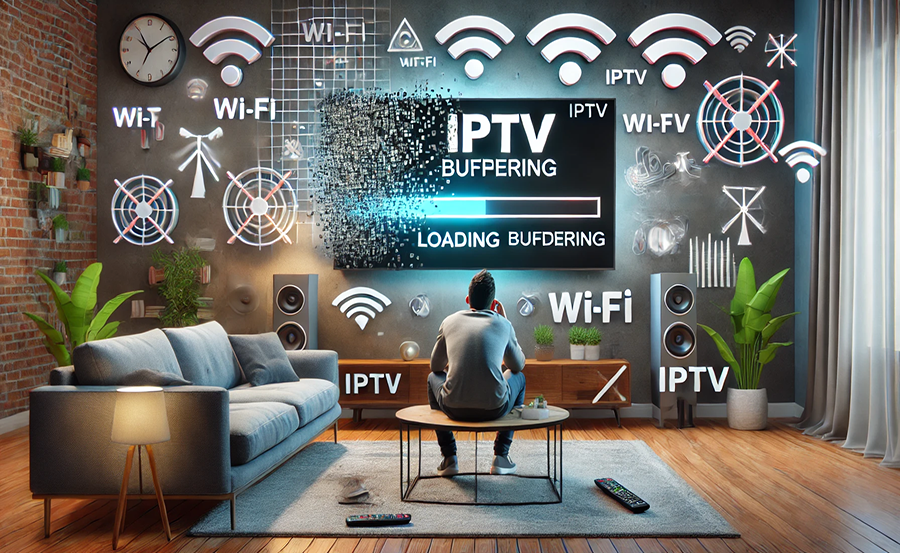Internet Protocol Television (IPTV) offers a modern alternative to traditional broadcast television. By streaming television content over the internet, IPTV services, such as Kemo IPTV, provide unparalleled access to a multitude of channels and programming right at your fingertips. However, great features often come with their set of challenges, especially when utilized over shared Wi-Fi networks that might not be optimized for high-speed broadcasting.
Imagine you’re at home, ready to watch your favorite sports game, but the stream keeps buffering. Annoying, right? This frustration is often the result of several factors unique to IPTV streaming over shared networks. Understanding these issues is the first step to ensuring an uninterrupted and enjoyable viewing experience.
Buy 1 Year IPTV Subscription and Enjoy Unlimited Content
What is IPTV?
IPTV stands for Internet Protocol Television. It’s a service that uses the Internet protocol to deliver television content rather than traditional means like cable or satellite. It’s not just about live broadcasts; IPTV also includes video on demand, series, and catch-up TV, making television consumption a highly customizable experience.
One of the top names in the IPTV world is Kemo IPTV. Known for its vast array of channels and consistent performance, KemoIPTV offers an Unlimited IPTV Subscription that stands out for its reliability and extensive content library. Yet, to make the most out of IPTV, understanding your internet setup, especially shared Wi-Fi scenarios, is crucial.
Key Factors Affecting IPTV Performance on Shared Wi-Fi Networks
Let’s dive into some common issues affecting the performance of your IPTV services on shared Wi-Fi environments. While you might not have control over all these factors, knowing about them can help you pinpoint and troubleshoot problems effectively.
Bandwidth Allocation
Bandwidth plays a critical role in determining the quality of IPTV streams. Shared Wi-Fi networks can lead to bottlenecks due to multiple users attempting to access bandwidth-intensive services simultaneously. This scenario often happens in households or shared living spaces where everyone’s online activities can interfere with each other.
Consider prioritizing bandwidth for IPTV. Some routers have the capability to allocate more bandwidth to streaming services through Quality of Service (QoS) settings. This can significantly enhance the performance of your Kemo IPTV subscription.
Network Congestion and Interference
Besides bandwidth, the physical environment of your Wi-Fi setup can also impact performance. Devices such as microwaves, cordless phones, and other Wi-Fi networks nearby can cause interference, leading to packet loss and reduced streaming quality.
To mitigate interference, ensure your router is placed in a central location away from obstructions and electronic devices. Using a 5GHz band where available can also help, as it’s less crowded and offers more channels than the traditional 2.4GHz band.
Router Configuration
Sometimes, issues lie within the router’s configuration itself. Old firmware or incorrect settings can limit your router’s performance capabilities. Regular updates and ensuring settings are optimized for streaming can assist in better IPTV performance.
It’s worth consulting the router’s manual or technical support to explore settings that could help streamline your IPTV experience.
Device Optimization and Hardware Limitations
While Wi-Fi issues are common, sometimes the device used for streaming IPTV might not be up to par. Older devices or those with limited processing power can struggle to handle high-definition streams efficiently.
Upgrading your streaming device or ensuring it’s optimized for performance by closing unnecessary applications and keeping software up to date can alleviate some performance-related issues.
Promoting Kemo IPTV: Why It’s the Best
Even with all these factors in play, Kemo IPTV has proven to be a leader in providing a solid IPTV experience. With an Unlimited IPTV Subscription, you get:
- Access to a vast range of international channels.
- Excellent customer support to assist with any technical inquiries.
- A user-friendly interface suitable for all age groups.
What truly sets KemoIPTV apart is their commitment to ensuring consistency in stream quality despite the best-effort nature of internet connectivity. They continuously work behind the scenes to ensure their servers are robust and up to the challenges posed by shared network environments.
Compatibility and Accessibility
Kemo IPTV’s wide-ranging device compatibility ensures users can enjoy their content on almost any device, be it smart TVs, tablets, smartphones, or laptops. This flexibility is part of what makes the service a top pick for diverse audiences.
Furthermore, the intuitive user interface allows subscribers to navigate through channels and content effortlessly, contributing to an overall satisfying user experience.
Sneaky Tips for Better IPTV Experience
A few tweaks here and there can significantly enhance your IPTV streaming experience, particularly on shared networks. Let’s explore some strategies you can implement immediately.
Opt for Wired Connections
When possible, connecting your major streaming device directly to the router via an Ethernet cable can provide a more stable connection compared to Wi-Fi. This method bypasses many of the common issues associated with wireless network streaming.
Check for ISP Throttling
Internet Service Providers (ISPs) sometimes throttle bandwidth for streaming services as a way to manage network congestion. You can check for throttling issues by running speed tests and comparing them with your subscribed internet plan.
Contacting your ISP
If discrepancies are found, it might be worth contacting the ISP. In some cases, upgrading to a higher tier can resolve streaming stutters, ensuring smoother IPTV performance.
Goodbye Buffering: Putting It All Together
By understanding and managing network parameters, optimizing devices, and choosing the right IPTV provider like Kemo IPTV, buffering and performance jitters can become issues of the past. Taking proactive steps will not only improve your streaming experience but also allow you to fully harness KemoIPTV’s incredible offerings with peace of mind.
Remember, the digital world is fast-evolving and staying one step ahead by being aware of potential pitfalls can ensure a seamless viewing experience. Kemo IPTV continues to innovate, making it the top-choice for IPTV enthusiasts worldwide.
FAQ Section

What makes Kemo IPTV different from other IPTV services?
Kemo IPTV stands out due to its extensive range of channels, exceptional customer service, and consistent performance even on shared networks. The Unlimited IPTV Subscription offers unmatched flexibility and content choices.
How can I optimize my network for IPTV streaming?
Consider prioritizing IPTV on your router’s Quality of Service settings, reduce interference, and check your connectivity options. A wired connection, where possible, is often more reliable than Wi-Fi.
Does Kemo IPTV support all device types?
Yes, Kemo IPTV is compatible with a wide range of devices including smart TVs, tablets, smartphones, and PCs. This versatility ensures you can enjoy your IPTV experience across numerous platforms.
What should I do if I experience persistent buffering?
Try checking your network settings, upgrade device software, or directly connecting to your router using a cable. Additionally, exploring your ISP’s terms regarding streaming throttling can help identify the cause.
Is there a trial period available for Kemo IPTV?
Yes, Kemo IPTV often offers trial periods for new users. This allows prospective customers to experience their unlimited channels and assess the service performance, ensuring it’s a fit for their needs.
How to Install IPTV Smarters on Roku: A Complete Guide

